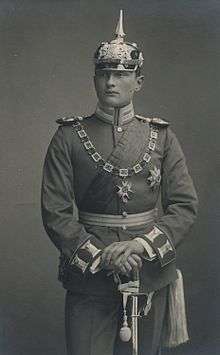Prince Heinrich of Bavaria
Prince Heinrich of Bavaria (24 June 1884 – 8 November 1916) was a member of the Bavarian Royal House of Wittelsbach and a highly decorated Army officer in the First World War.
| Prince Heinrich | |
|---|---|
 | |
| Born | 24 June 1884 Munich, Bavaria |
| Died | 7 November 1916 (aged 32)[1] Argeș County, Romania |
| Burial | |
| House | Wittelsbach |
| Father | Prince Arnulf of Bavaria |
| Mother | Princess Therese of Liechtenstein |
Early life
Heinrich was born in Munich, Bavaria. He was the only child of Prince Arnulf of Bavaria and his wife Princess Therese of Liechtenstein.
Heinrich was brought up in Munich, where one of his tutors was Joseph Gebhard Himmler, the father of Heinrich Himmler. The elder Himmler was an ardent royalist who, following the birth of his second son, petitioned the prince to allow him to be named after him - Heinrich. The prince agreed and also became Heinrich Himmler's godfather.[2] "{H}e took a lively interest in the progress of his godson and in how the Himmlers were faring. It was a warm relationship, as is shown by the preserved correspondence between Gebhard and the prince; at Christmas the Himmlers regularly received a visit from the prince and his mother..."[3]
Military career and death
At the age of 17, following his Abitur, Heinrich joined the Bavarian army with the rank of Leutnant. Initially, he served with the Royal Bavarian Infanterie-Leib-Regiment, but later was reassigned the 1st Royal Bavarian Heavy Cavalry “Prince Charles of Bavaria”.
After the outbreak of World War I, the regiment saw action on the Western front, where Prince Heinrich was badly wounded. Upon recovering, he returned to his old infantry regiment and in June 1915, was promoted to Major. At the same time, he was put in charge of the III. Battalion of the newly established Deutsches Alpenkorps stationed in the Carnic Alps. In late 1916, the battalion was transferred to Romania where it fought at Turnu Roşu Pass. On 7 November 1916, during operations in the area near Poiana Spinului, while conducting a personal reconnaissance of the front line, his life was claimed by Romanian rifle fire.[4]
Heinrich's body was transported back to Munich, where he was buried by his father’s side at the Theatinerkirche. Posthumously on 6 March 1917, for his exceptional bravery, he was awarded the Knight's Cross of the Military Order of Max Joseph. He had previously been awarded the Iron Cross, 1st class for actions in June 1916.
Ancestry
| Ancestors of Prince Heinrich of Bavaria | |||||||||||||||||||||||||||||||||||||||||||||||||||||||||||||||||||||||||||||||||||||||||||||||||||||||||||||||||||||||||||||||||||||||||||||||||||||||||||||||||||||||||||||||||||||||||||||||||||||||||||||||||||||||||||||||||||||||||||||||||||||||||||||||||||||||||||||||||||||||||
|---|---|---|---|---|---|---|---|---|---|---|---|---|---|---|---|---|---|---|---|---|---|---|---|---|---|---|---|---|---|---|---|---|---|---|---|---|---|---|---|---|---|---|---|---|---|---|---|---|---|---|---|---|---|---|---|---|---|---|---|---|---|---|---|---|---|---|---|---|---|---|---|---|---|---|---|---|---|---|---|---|---|---|---|---|---|---|---|---|---|---|---|---|---|---|---|---|---|---|---|---|---|---|---|---|---|---|---|---|---|---|---|---|---|---|---|---|---|---|---|---|---|---|---|---|---|---|---|---|---|---|---|---|---|---|---|---|---|---|---|---|---|---|---|---|---|---|---|---|---|---|---|---|---|---|---|---|---|---|---|---|---|---|---|---|---|---|---|---|---|---|---|---|---|---|---|---|---|---|---|---|---|---|---|---|---|---|---|---|---|---|---|---|---|---|---|---|---|---|---|---|---|---|---|---|---|---|---|---|---|---|---|---|---|---|---|---|---|---|---|---|---|---|---|---|---|---|---|---|---|---|---|---|---|---|---|---|---|---|---|---|---|---|---|---|---|---|---|---|---|---|---|---|---|---|---|---|---|---|---|---|---|---|---|---|---|---|---|---|---|---|---|---|---|---|---|---|---|---|---|---|---|
| |||||||||||||||||||||||||||||||||||||||||||||||||||||||||||||||||||||||||||||||||||||||||||||||||||||||||||||||||||||||||||||||||||||||||||||||||||||||||||||||||||||||||||||||||||||||||||||||||||||||||||||||||||||||||||||||||||||||||||||||||||||||||||||||||||||||||||||||||||||||||
References
- Michael B. Barrett, Indiana University Press, 2013, Prelude to Blitzkrieg: The 1916 Austro-German Campaign in Romania, p. 160
- Breitman, p. 9
- Longerich p. 15,
- Michael B. Barrett, Indiana University Press, 2013, Prelude to Blitzkrieg: The 1916 Austro-German Campaign in Romania, p. 160
Sources
- Peter Longerich, Heinrich Himmler: A Life, Oxford: Oxford University Press. ISBN 978-0-19-965174-0
- Jirí Louda and Michael MacLagan, Lines of Succession: Heraldry of the Royal Families of Europe, 2nd edition (London, U.K.: Little, Brown and Company, 1999)
- Breitman, Richard (2004). Himmler and the Final Solution: The Architect of Genocide. Pimlico, Random House, London. ISBN 1-84413-089-4.